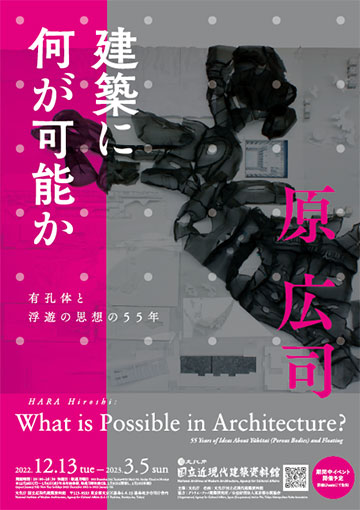2022 Exhibition HARA Hiroshi: “What is Possible in Architecture?” 55 Years of Ideas About Yūkōtai (Porous Bodies) and Floating
 |
2022 December.13rd, Tuesday –2023 March5th, Sunday. |
|---|
“2022 Exhibition HARA Hiroshi: “What is Possible in Architecture?” 55 Years of Ideas About Yukōtai (Porous Bodies) and Floating” was end.
During his 28 years teaching at the University of Tokyo, architect HARA Hiroshi created a wide range of architectural works, from private houses to museums and educational facilities, as well as large-scale structures such as train stations, high-rises, and sports domes. These include globally celebrated landmarks such as Kyoto Station Building, Umeda Sky Building, and Sapporo Dome.
HARA Hiroshi’s diverse speculations on architecture, which incorporate mathematics, philosophy, and art, have greatly affected the development of contemporary architecture in Japan. Starting with the notions of Yukōtai (porous bodies) and Floating in his exemplary 1967 book What is Possible in Architecture? and developing into diverse architectural concepts such as Reflection Houses, multilayered structures, a shift from function to modality, lessons from villages, and discrete spaces, HARA Hiroshi’s ideas have had an incalculable influence on contemporary architecture. Moreover, HARA Hiroshi has made great contributions to exchanges with other cultural fields. One example is his design for Ose Middle School, located in the hometown of his friend, the novelist OE Kenzaburo, which appears in an altered form in the latter’s 1995 novel Moeagarumidori no Ki (The Burning Green Tree).
This exhibition will comprise drawings and sketches selected from architectural materials being donated by HARA Hiroshi + Atelier Phi to the National Archives of Modern Architecture, comprising drawings and sketches that reveal the chronological development of the themes of Yukōtai (porous bodies) and Floating. The exhibition will focus on the ways in which these two concepts, within which lie the origins of HARA Hiroshi’s work, have been implemented and developed in everything from houses to large-scale buildings and cities. Through exhibits subdivided into three types of “thought” (“Ideas: Objects, Images, Texts” “Proposals: Sketches” “Realizations: Design Drawings”) the exhibition will create a place in which visitors may decipher the relationships between HARA Hiroshi’s ideas and built architectural works, and appreciate the thinking and intellectual approaches that lie behind his creative architectural designs.
Organization:Agency for Cultural Affairs, Japan
Cooperation:Atelier Phi, Tokyo Metropolitan Parks Association
Venue:National Archives of Modern Architecture, Agency for Cultural Affairs (4-6-15 Yushima, Bunkyo-ku, Tokyo)
Tel: 03-3812-3401 Fax: 03-3812-3407
Date:2022 December.13rd, Tuesday –2023 March5th, Sunday.
Closed on Mondays (expect January9th) New Year holidays 2022 December 26thto 2023 January 4
Contents
1. Birth of the Notions of “Yukotai” (Porous Bodies) and “Floating” / 1960s
Ito House (1967), Keisho Kindergarten (1967)
2. Reflection Houses and the Surveys of Villages around the World / 1970s
Hara House (1974), Niram House (1978), Kudo Villa (1976)
3. Public Architecture and the Theory of Modality / 1980s
Tasaki Museum of Art(1986),Iida City Museum(1988), Yamato International(1986), Josei Primary School(1987), Ōse Middle School(1992)
4. Implementation of “Yukotai” (Porous Bodies) and “Floating” in Large-Scale Architecture / 1990s
Umeda Sky Building (1993), Kyoto Station Building (1997), Miyagi Prefectural Library (1998), Sapporo Dome (2001)
X. Competitions and Imaginary Projects
500M x 500M x 500M (1992), New Region Piemonte Building in Turin, Italy [Torino1] (2000), Casa Experimental Latin America (2003)
inquiry
National Archives of Modern Architecture, Agency for Cultural Affairs
https://nama.bunka.go.jp
TEL 03-3812-3401 FAX 03-3812-3407
nama@mext.go.jp
